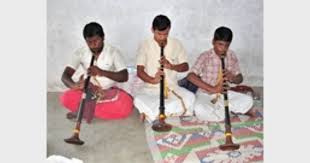
"Nadaswaram and Shehnai: The Enchanting Reverberations of Traditional Wind Instruments"
In the rich tapestry of Indian classical music, the Nadaswaram and Shehnai emerge as iconic wind instruments, their resonating melodies weaving tales of tradition, cultural richness, and spiritual resonance. These instruments, deeply rooted in heritage and cherished across regions, hold a revered place in ceremonial occasions, temples, and musical performances. Let's embark on a melodic journey to uncover the essence, heritage, craftsmanship, and cultural significance of the Nadaswaram and Shehnai.
Nadaswaram: Echoes of Sacred Traditions
Cultural Heritage:
Originating from South India, the Nadaswaram carries an ancient legacy steeped in spirituality and devotion. It has a prominent presence in auspicious ceremonies, temple rituals, weddings, and cultural celebrations, symbolizing divine blessings and prosperity.
Sonorous Tones:
Crafted from a combination of wood and brass, the Nadaswaram's design allows it to produce rich, resonant tones with a distinctive timbre. Its long, cylindrical shape and double reed mouthpiece create a full-bodied sound, capable of evoking a range of emotions.
Ceremonial Significance:
The Nadaswaram's melodies, characterized by intricate 'ragas' and rhythmic patterns, elevate the ambiance of religious processions and traditional rituals. Its auspicious presence is believed to invoke blessings and spiritual sanctity.
Shehnai: The Celebratory Serenade
Historical Roots:
Hailing from North India, the Shehnai has a historical lineage dating back centuries, entwined with courtly music and festive traditions. It has been an integral part of weddings, religious festivals, and cultural events.
Unique Tonality:
Crafted from wood with a double reed mouthpiece, the Shehnai produces a melodious, nasal timbre that resonates with festive cheer. Its ability to convey joy, celebration, and vibrant emotions makes it an essential accompaniment in ceremonial music.
Ceremonial Significance:
The Shehnai's tunes are synonymous with auspicious beginnings, heralding joy and happiness. Its melodies, often played during processions and wedding ceremonies, add a jubilant and celebratory atmosphere to cultural gatherings.
Cultural Harmony and Spiritual Reverberation
Both the Nadaswaram and Shehnai, while geographically distinct, share a common thread—their ability to transcend linguistic barriers and evoke emotions through their melodic charm. These instruments symbolize unity, heritage, and spiritual fervor in Indian classical music.
Conclusion: Melodies of Tradition and Festivity
As the Nadaswaram's sacred notes merge with the Shehnai's celebratory tunes, they paint a vivid tapestry of cultural richness and emotive resonance. Both instruments, with their distinct voices, echo the spirit of tradition, festivity, and spirituality inherent in Indian classical music.
Their melodies echo through temples, weddings, and celebratory processions, serving as musical ambassadors of India's rich cultural heritage—a testament to the enduring power of these wind instruments in evoking emotions and capturing the essence of tradition and celebration.
The Nadaswaram and Shehnai, with their evocative melodies and cultural significance, continue to enchant and resonate as integral parts of ceremonial and cultural events in India.
ABOUT AUTHOR : Musicintuit Admin
EXPLORE OUR ARRAY OF ONLINE MUSIC COURSES: Musicintuit Courses
ENROLL TODAY ! EXPLORE AND IMMERSE YOURSELF IN THE REALM OF MUSIC: Contact Musicintuit




